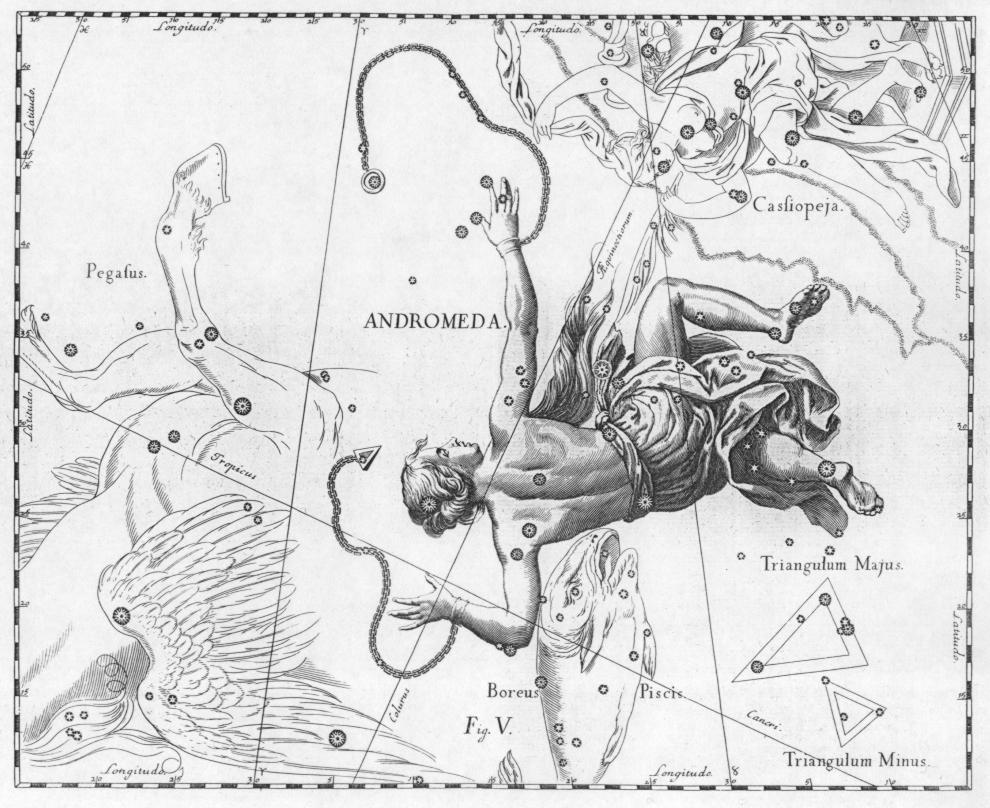|
Kappa Andromedae
Kappa Andromedae, Latinized from κ Andromedae, is the Bayer designation for a bright star in the northern constellation of Andromeda. It is visible to the naked eye with an apparent visual magnitude of 4.1. Based on the star's ranking on the Bortle Dark-Sky Scale, it is luminous enough to be visible from the suburbs and from urban outskirts, but not from brightly lit inner city regions. Parallax measurements made during the Hipparcos mission place it at a distance of approximately from the Sun. It is drifting closer with a radial velocity of −15 km/s, and there is a high likelihood (86%) that it is a member of the Beta Pictoris moving group. The star has one known companion exoplanet, Kappa Andromedae b. Properties The stellar classification of Kappa Andromedae is B9 IVn, indicating that it is a subgiant star in the process of evolving away from the main sequence. The star has an estimated 2.8 times the mass of the Sun and is radiating 78.5 times the Sun's ... [...More Info...] [...Related Items...] OR: [Wikipedia] [Google] [Baidu] |
Andromeda (constellation)
Andromeda is one of the 48 constellations listed by the 2nd-century Greco-Roman astronomer Ptolemy, and one of the 88 modern constellations. Located in the northern celestial hemisphere, it is named for Andromeda, daughter of Cassiopeia, in the Greek myth, who was chained to a rock to be eaten by the sea monster Cetus. Andromeda is most prominent during autumn evenings in the Northern Hemisphere, along with several other constellations named for characters in the Perseus myth. Because of its northern declination, Andromeda is visible only north of 40° south latitude; for observers farther south, it lies below the horizon. It is one of the largest constellations, with an area of 722 square degrees. This is over 1,400 times the size of the full moon, 55% of the size of the largest constellation, Hydra, and over 10 times the size of the smallest constellation, Crux. Its brightest star, Alpha Andromedae, is a binary star that has also been counted as a part of Pegasu ... [...More Info...] [...Related Items...] OR: [Wikipedia] [Google] [Baidu] |
Mass Of The Sun
The solar mass () is a standard unit of mass in astronomy, equal to approximately . It is often used to indicate the masses of other stars, as well as stellar clusters, nebulae, galaxies and black holes. It is approximately equal to the mass of the Sun. This equates to about two nonillion ( short scale), two quintillion (long scale) kilograms or 2000 quettagrams: The solar mass is about times the mass of Earth (), or times the mass of Jupiter (). History of measurement The value of the gravitational constant was first derived from measurements that were made by Henry Cavendish in 1798 with a torsion balance. The value he obtained differs by only 1% from the modern value, but was not as precise. The diurnal parallax of the Sun was accurately measured during the transits of Venus in 1761 and 1769, yielding a value of (9 arcseconds, compared to the present value of ). From the value of the diurnal parallax, one can determine the distance to the Sun from the geometry ... [...More Info...] [...Related Items...] OR: [Wikipedia] [Google] [Baidu] |
Flying Serpent (asterism)
Flying Serpent (''Tengshe'' 螣蛇) is an asterism (name for a group of stars) in the constellation "Encampment" (''Shixiu'' 室宿) in the Chinese constellation system. It is named after the mythological serpent, '' tengshe''. The ''Tengshe'' asterism was a group of "22 stars, occurring in the northern artof the "Encampment" () constellation, epresenting; or comprising the figure ofthe Heavenly Snake, chief of the water reptiles", according to the treatise on astronomy in the ''Book of Jin'' (''Jin Shu''). The Tengshe coincides with the lizard constellation Lacerta Lacerta is one of the 88 modern constellations defined by the International Astronomical Union. Its name is Latin for lizard. A small, faint constellation, it was defined in 1687 by the astronomer Johannes Hevelius. Its brightest stars form a "W ..., and the northern parts of Lacerta occupy the center of Tengshe. References Chinese constellations {{China-stub ... [...More Info...] [...Related Items...] OR: [Wikipedia] [Google] [Baidu] |
Chinese Astronomy
Astronomy in China has a long history stretching from the Shang dynasty, being refined over a period of more than 3,000 years. The ancient Chinese people have identified stars from 1300 BCE, as Chinese star names later categorized in the twenty-eight mansions have been found on oracle bones unearthed at Anyang, dating back to the mid-Shang dynasty. The core of the "mansion" (宿 ''xiù'') system also took shape around this period, by the time of King Wu Ding (1250–1192 BCE). Detailed records of astronomical observations began during the Warring States period (fourth century BCE) and flourished from the Han period onward. Chinese astronomy was equatorial, centered on close observation of circumpolar stars, and was based on different principles from those in traditional Western astronomy, where heliacal risings and settings of zodiac constellations formed the basic ecliptic framework. Joseph Needham has described the ancient Chinese as the most persistent and accurat ... [...More Info...] [...Related Items...] OR: [Wikipedia] [Google] [Baidu] |
Year
A year or annus is the orbital period of a planetary body, for example, the Earth, moving in its orbit around the Sun. Due to the Earth's axial tilt, the course of a year sees the passing of the seasons, marked by change in weather, the hours of daylight, and, consequently, vegetation and soil fertility. In temperate and subpolar regions around the planet, four seasons are generally recognized: spring, summer, autumn and winter. In tropical and subtropical regions, several geographical sectors do not present defined seasons; but in the seasonal tropics, the annual wet and dry seasons are recognized and tracked. A calendar year is an approximation of the number of days of the Earth's orbital period, as counted in a given calendar. The Gregorian calendar, or modern calendar, presents its calendar year to be either a common year of 365 days or a leap year of 366 days, as do the Julian calendars. For the Gregorian calendar, the average length of the calendar yea ... [...More Info...] [...Related Items...] OR: [Wikipedia] [Google] [Baidu] |
Astronomical Unit
The astronomical unit (symbol: au, or or AU) is a unit of length, roughly the distance from Earth to the Sun and approximately equal to or 8.3 light-minutes. The actual distance from Earth to the Sun varies by about 3% as Earth orbits the Sun, from a maximum ( aphelion) to a minimum ( perihelion) and back again once each year. The astronomical unit was originally conceived as the average of Earth's aphelion and perihelion; however, since 2012 it has been defined as exactly (see below for several conversions). The astronomical unit is used primarily for measuring distances within the Solar System or around other stars. It is also a fundamental component in the definition of another unit of astronomical length, the parsec. History of symbol usage A variety of unit symbols and abbreviations have been in use for the astronomical unit. In a 1976 resolution, the International Astronomical Union (IAU) had used the symbol ''A'' to denote a length equal to the ast ... [...More Info...] [...Related Items...] OR: [Wikipedia] [Google] [Baidu] |
Large Binocular Telescope
The Large Binocular Telescope (LBT) is an optical telescope for astronomy located on Mount Graham, in the Pinaleno Mountains of southeastern Arizona, United States. It is a part of the Mount Graham International Observatory. When using both 8.4 m (330 inch) wide mirrors, with centres 14.4 m apart, the LBT has the same light-gathering ability as a 11.8 m (464 inch) wide single circular telescope and the resolution of a 22.8 m (897 inch) wide one. The LBT mirrors individually are the joint second- largest optical telescope in continental North America, next to the Hobby–Eberly Telescope in West Texas. It has the largest monolithic, or in an optical telescope. Strehl ratios of 60–90% in the infrared H band and 95% in the infrared M band have been achieved by the LBT. Project The LBT was originally named the "Columbus Project." It is a joint project of these members: the Italian astronomical community represented by the Istituto Naziona ... [...More Info...] [...Related Items...] OR: [Wikipedia] [Google] [Baidu] |
Keck Observatory
The W. M. Keck Observatory is an astronomical observatory with two telescopes at an elevation of 4,145 meters (13,600 ft) near the summit of Mauna Kea in the U.S. state of Hawaii. Both telescopes have aperture primary mirrors, and when completed in 1993 (Keck 1) and 1996 (Keck 2) were the largest astronomical telescopes in the world. They are currently the 3rd and 4th largest. Overview With a concept first proposed in 1977, telescope designers at the University of California, Berkeley (Terry Mast) and Lawrence Berkeley Laboratory (Jerry Nelson) had been developing the technology necessary to build a large, ground-based telescope. With a design in hand, a search for the funding began. In 1985, Howard B. Keck of the W. M. Keck Foundation gave $70 million to fund the construction of the Keck I telescope, which began in September 1985, with first light occurring on 24 November 1990 using nine of the eventual 36 segments. With construction of the first telescope well ... [...More Info...] [...Related Items...] OR: [Wikipedia] [Google] [Baidu] |
Subaru Telescope
is the telescope of the National Astronomical Observatory of Japan, located at the Mauna Kea Observatory on Hawaii. It is named after the open star cluster known in English as the Pleiades. It had the largest monolithic primary mirror in the world from its commissioning until 2005. Overview The Subaru Telescope is a Ritchey-Chretien reflecting telescope. Instruments can be mounted at a Cassegrain focus below the primary mirror; at either of two Nasmyth focal points in enclosures on the sides of the telescope mount, to which light can be directed with a tertiary mirror; or at the prime focus in lieu of a secondary mirror, an arrangement rare on large telescopes, to provide a wide field of view suited to deep wide-field surveys. In 1984, the University of Tokyo formed an engineering working group to develop and study the concept of a telescope. In 1985, the astronomy committee of Japan's science council gave top priority to the development of a "Japan National Large ... [...More Info...] [...Related Items...] OR: [Wikipedia] [Google] [Baidu] |
Strategic Explorations Of Exoplanets And Disks With Subaru
Strategic Explorations of Exoplanets and Disks with Subaru (SEEDS) is a multi-year survey that used the Subaru Telescope on Mauna Kea, Hawaii in an effort to directly image extrasolar planets and protoplanetary/debris disks around hundreds of nearby stars. SEEDS is a Japanese-led international project. It consists of some 120 researchers from a number of institutions in Japan, the U.S. and the EU. The survey's headquarters is at the National Astronomical Observatory of Japan (NAOJ) and led by Principal Investigator Motohide Tamura. The goals of the survey are to address the following key issues in the study of extrasolar planets and disks: the detection and census of exoplanets in the regions around solar-mass and massive stars; the evolution of protoplanetary disks and debris disks; and the link between exoplanets and circumstellar disks. Observations and Results The direct imaging survey was carried out with a suite of high-contrast instrumentation at the large Subaru 8.2 m ... [...More Info...] [...Related Items...] OR: [Wikipedia] [Google] [Baidu] |
Kappa Andromedae Star Chart No Labels
Kappa (uppercase Κ, lowercase κ or cursive ; el, κάππα, ''káppa'') is the 10th letter of the Greek alphabet, representing the voiceless velar plosive sound in Ancient and Modern Greek. In the system of Greek numerals, has a value of 20. It was derived from the Phoenician letter kaph . Letters that arose from kappa include the Roman K and Cyrillic К. The uppercase form is identical to the Latin K. Greek proper names and placenames containing kappa are often written in English with "c" due to the Romans' transliterations into the Latin alphabet: Constantinople, Corinth, Crete. All formal modern romanizations of Greek now use the letter "k", however. The cursive form is generally a simple font variant of lower-case kappa, but it is encoded separately in Unicode for occasions where it is used as a separate symbol in math and science. In mathematics, the kappa curve is named after this letter; the tangents of this curve were first calculated by Isaac Barrow in t ... [...More Info...] [...Related Items...] OR: [Wikipedia] [Google] [Baidu] |






